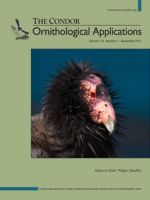Adaptive habitat-selection theory predicts that individuals should use habitats that maximize lifetime fitness. However, trade-offs between life-history stages, environmental variability, and predator–prey dynamics can interact with individual preferences, which may result in individuals selecting suboptimal habitats. Understanding the distinction between adaptive and maladaptive animal use of habitat is central to effective species conservation, because use of maladaptive habitat is counter to conservation objectives. Our objectives were to assess whether habitat characteristics selected by Greater Sage-Grouse (Centrocercus urophasianus) were correlated with increased production of fledged young. We monitored 411 nests and 120 broods from 234 females between 2004 and 2012 in central Nevada, USA. We determined which habitat characteristics were selected as nesting habitat and assessed whether these characteristics influenced nest success and early offspring survival. The relationships between characteristics selected at nest sites and metrics of reproductive success were variable, in that certain characteristics (e.g., forb cover, amount of pinyon–juniper woodlands) were correlated with higher nest survival and chick survival, but other characteristics (e.g., amount of sagebrush, residual grass height) did not improve reproductive success. Despite variability among predictor variables, we found a positive effect of selection of fine-scale habitat characteristics on nest (βNS-Local = 0.14, 85% confidence interval [CI]: 0.04–0.23) and chick survival (βCS-Local = 0.39, 85% CI: 0.27–0.50); however, we did not find that selection of broad-scale habitat characteristics predicted reproductive success (βNS-Landscape = −0.04, 85% CI: −0.15 to 0.06; βCS-Landscape = 0.06, 85% CI: −0.06 to 0.18). Additionally, nest-site selection was more predictive of chick survival than of nest survival, which suggests that females' selection of nesting habitat was based primarily on its qualities as brood-rearing habitat. Together, these findings suggest that nest-site selection may be influenced by more than increased reproductive success, or that there is a landscape-level pattern to local-scale habitat characteristics.
How to translate text using browser tools
14 September 2016
Nesting habitat selection influences nest and early offspring survival in Greater Sage-Grouse
Daniel Gibson,
Erik J. Blomberg,
Michael T. Atamian,
James S. Sedinger
ACCESS THE FULL ARTICLE

The Condor
Vol. 118 • No. 4
November 2016
Vol. 118 • No. 4
November 2016
Centrocercus urophasianus
greater sage-grouse
habitat selection
reproductive success




